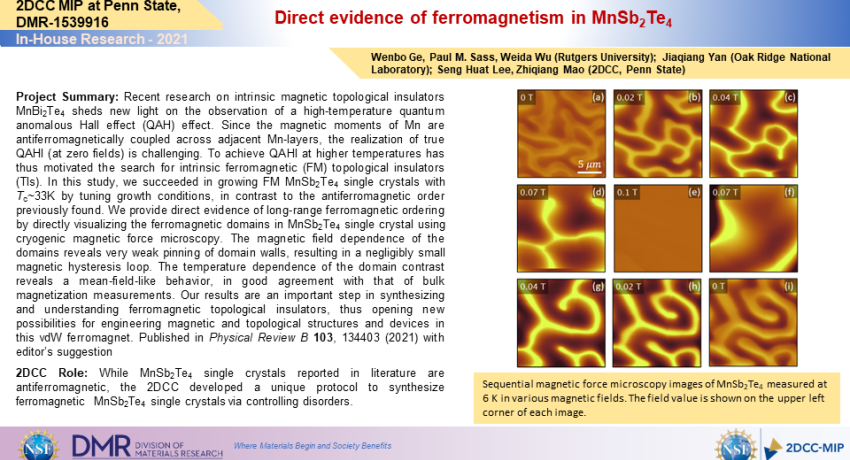Project Summary: Recent research on intrinsic magnetic topological insulators MnBi2Te4 sheds new light on the observation of a high-temperature quantum anomalous Hall effect (QAH) effect. Since the magnetic moments of Mn are antiferromagnetically coupled across adjacent Mn-layers, the realization of true QAHI (at zero fields) is challenging. To achieve QAHI at higher temperatures has thus motivated the search for intrinsic ferromagnetic (FM) topological insulators (TIs). In this study, we succeeded in growing FM MnSb2Te4 single crystals with Tc~33K by tuning growth conditions, in contrast to the antiferromagnetic order previously found. We provide direct evidence of long-range ferromagnetic ordering by directly visualizing the ferromagnetic domains in MnSb2Te4 single crystal using cryogenic magnetic force microscopy. The magnetic field dependence of the domains reveals very weak pinning of domain walls, resulting in a negligibly small magnetic hysteresis loop. The temperature dependence of the domain contrast reveals a mean-field-like behavior, in good agreement with that of bulk magnetization measurements. Our results are an important step in synthesizing and understanding ferromagnetic topological insulators, thus opening new possibilities for engineering magnetic and topological structures and devices in this vdW ferromagnet. Published in Physical Review B 103, 134403 (2021) with editor’s suggestion
2DCC Role: While MnSb2Te4 single crystals reported in literature are antiferromagnetic, the 2DCC developed a unique protocol to synthesize ferromagnetic MnSb2Te4 single crystals via controlling disorders.
What Has Been Achieved: A ferromagnetic (FM) phase of MnSb2Te4 has been demonstrated via magnetic force microscopy magnetic domain imaging. This phase is found to be sensitive to disorders and can be stabilized via controlling disorders.
Importance of the Achievement: This work is not only an encouraging step towards realizing a FM topological insulator but also stimulate future studies to understand and control the synthesis conditions that lead to different magnetic orders in the Mn(Bi,Sb)2nTe3n+1 family and further explorations of their topological and magnetic properties.
Unique Feature(s) of the MIP that Enabled this Achievement: the 2DCC developed a unique protocol to synthesize ferromagnetic MnSb2Te4 single crystals via controlling disorders. The level of disorders is found be tunable via adjusting thermal treatment conditions.
(If Applicable) Publication:
Wenbo Ge, Paul M. Sass, Jiaqiang Yan, Seng Huat Lee, Zhiqiang Mao, and Weida Wu, Physical Review B 103, 134403 (2021). DOI:10.1103/PhysRevB.103.134403
The MFM studies at Rutgers are supported by the Office of Basic Energy Sciences, Division of Materials Sciences and Engineering, U.S. Department of Energy under Award No. DE-SC0018153. Work at ORNL was supported by the U.S. Department of Energy, Office of Science, Basic Energy Sciences, Materials Sciences and Engineering Division. Support for crystal growth and characterization at Penn State was provided by the National Science Foundation through the Penn State 2D Crystal Consortium-Materials Innovation Platform (2DCC-MIP) under NSF Cooperative Agreement DMR-1539916.
